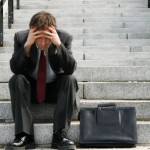 For the impatient: If you are thinking about enrolling in law school as a result of dreaming of six-figure salaries, it is a requirement that you attend one of the best law schools in the country and achieve a very high class rank after your first year of law school.
For the impatient: If you are thinking about enrolling in law school as a result of dreaming of six-figure salaries, it is a requirement that you attend one of the best law schools in the country and achieve a very high class rank after your first year of law school.
The vast majority of students entering law school each year are doing so because they seek a financially secure career and believe the field of law will secure them this objective. The allure of the law is not surprising, even in the midst of the recession, because somewhere out there some law school graduates are securing six-figure salaries straight out of law school. It is not hard to imagine how captivating this potential outcome is to the minds of fresh college graduates. After all, if there’s a will there’s a way, and so the enrollments continue even as tuition continues to rise with each coming year. What most law school students do not understand, however, is that the potential to make this exciting amount of money straight out of law school involves the proper execution of a particular set of steps that begin prior to enrollment, and most law school students are foreclosed from this opportunity simply based on where they enroll in law school. To understand why that is the case, one must first understand the process of 2L On Campus Interviews (“2L OCI”), which represents 95% or more of how such high paying jobs at big firms are obtained.
In a nutshell, 2L OCI occurs after a law school student’s first year of law school, but immediately prior to the start of his or her second year. No different than something some students may have experienced in college, it is a span of time (typically, a 3-5 day window) when employers largely from the biggest firms in the law school’s region (offering these high salaries) come to the law school and interview certain students from the incoming 2L class. The purpose of these interviews is to pick out the best students in the class to join the firm for the following summer as summer associates. It is then expected that these summer associates will work for a period of 8-12 weeks for their firm over their 2L summer as associates-to-be. Generally speaking, during this summer associate internship the students are paid at first-year rates, with post-graduate employment largely secured (barring a student’s significant failure with respect to social interaction or work product, or increasingly nothing more than bad luck due to the recession).
This entire process doesn’t sound too bad, an incoming 2L just has to blow away the interviewers, right? Ignoring the difficulty of the interview process itself, the reality of how this all works begins to dawn on you only after filling in the important details. For one, the reason these firms pay such high salaries is to attract the brightest talent from each incoming 2L class, the belief is that the “potential” in these students is there and the firms will be able to mold them into great attorneys. That is fine, but what most prospective law students do not understand is that there is a severely limited amount of these summer associate positions in relation to the amount of law school students in each year’s class across the nation. For a more detailed analysis of the numbers, visit our Do Your Law School Research article. In short, in recent years there have been around 40,000 law school students in each incoming class, and around 4 thousand summer associate positions. Therefore, at best, only about 1 in 10 students will have the luxury of getting a summer associate position. This actually seems attainable, until something else is considered.
When law firms refer to attracting the brightest talent, they are referring to the best law school students at the best law schools in the country. This process doesn’t function on the premise that every law school student has an equal shot at securing this high paying post-graduate employment. On the contrary, this entire process is reserved for the law school students that appear, grade wise on paper at least, to have bested their peers at law schools that only admit the students with the best credentials (LSAT, undergraduate GPA). As a result, the average law school student at the average law school in the country has no chance to even play this game. In fact, the reality works something like this:
The weaker the credentials required for enrollment in the law school, the less likely it is that a big firm employer will conduct 2L OCI at that law school.
It gets to the point where some law schools do not even have 2L OCI, or so few employers visit the law school that it might as well not have it. The best chance to participate and have a shot at 2L OCI also correlates with the size of the market in which the law school resides. More big firms are naturally present in big cities such as NY, Chicago, Boston, Atlanta, or San Francisco. Therefore, the chances for a law student are never actually 1 in 10. The chances are a factor of law school prestige (more prestigious means more employers means more opportunities) and the law student’s rank after finishing their first year (the higher the student’s ranking in his or her class, the more opportunities are present). Neither of these two factors alone are sufficient, both are necessary because it could easily be the case that a student who is well below Top 50% (median) at a top school will not succeed at 2L OCI whereas a Top 1% student at a bottom school may very well obtain such employment depend on the market in which the student’s law school resides.
To best understand your particular chances, it is worth visiting Law School Transparency, which provides the most comprehensive analysis of law school jobs data. In addition, the National Law Journal compiled a list of the law schools that sent the highest percentage of their 2012 graduating class to big firms, the top 25 of which Professor Paul Caron over at TaxProf Blog kindly digested and put up. Needless to say, if this particular salary goal is your main priority as a prospective law student and your school is not on that list, it is time to re-evaluate where you need to attend law school. Keep in mind, however, based on everything discussed here, that even at the best of law schools nothing is guaranteed. For some useful general guidelines since the ushering in of the New Normal, here is a breakdown of what class rank an incoming 2L should attain at a particular law school using US News Law School Rankings (the actual relevance of which is discussed in our Do Your Research article linked to above):
This all comes full circle to bring about the final two points: rarely do prospective or first year law school students understand the importance of 1) first year grades for purposes of 2L OCI and 2) 2L OCI’s almost exclusive function as the means to obtaining big firm positions. With respect to grades, to the extent they are enrolled in a law school where 2L OCI is relatively strong, and they wish to take advantage of 2L OCI, it is imperative that incoming law students do everything they can to obtain a class rank as high as possible after finishing 1L year. To give themselves the best start, they should read our Law School Performance: The Hidden Reality and How to Take a Law School Exam articles. As to 2L OCI’s monopoly over big firm opportunities, once you miss the boat after your 1L year, with the rare exception, it is close to impossible that the doors to a big firm will open up for you again. After all, why would they? The following year there is a new crop of incoming 2Ls to start this whole process over again. For example, unlike what most law students imagine, there is really no such thing as “3L OCI” where students get a second shot to try for gold if 2L OCI did not work out. 3L OCI opportunities are so infinitesimal that it is unfortunate the process even has a name. To put numbers on these statements, NALP’s “Perspectives On Fall 2012 Law Student Recruiting” indicated a total of 82 offers were made to 3Ls by big firms across the entire country. To add insult to injury, many of these 82 offers went to 3Ls who had a summer associate position their 2L summer and simply wanted to go to a different firm. When law students without summer associate positions across the country have to compete with law students with summer associate positions wishing to switch, over a miniscule amount of potential openings, it does not validate 3L OCI. This simply reinforces the significance of 2L OCI.
In the end, the entire 2L OCI process may seem bizarre to the average layperson, prospective law student, or 1L. The fact big firms paying the biggest salaries pick out only the top law school students in each year’s incoming class is not surprising, but that this process occurs two years in advance of graduation may be striking. This is particularly so with respect to unaware 1L students that do not understand the significance of their first year academic performance or 2L OCI’s one chance window of opportunity. This whole process is generally not explained to prospective law school students, nor even to 1L students. It just “happens” after their 1L summer, and some students are either part of it or they are not, solely based on their first year grades. Knowing this information prior to deciding on law school will ensure prospective law students are more equipped to make an informed decision, with the understanding that such salaries are not handed out as an award post-graduation but are reserved for only the few.
 JDEmployed Where Law School Meets the Legal Market
JDEmployed Where Law School Meets the Legal Market





11 comments
Pingback: Law School Job Search Strategy: Don't be a Picky 3L (Chapter 2)
Pingback: Interview Fundamentals: Conversation, Confidence, Humor
Pingback: Law School Job Search Strategy: Do Grades Matter After 1L? (Chapter 3)
Pingback: The JD Law Degree: Dispelling the Myth of Versatility
Pingback: Law School Job Search Strategy: Real Networking (Chapter 4)
Pingback: Law School Job Search Strategy: Internships and Externships (Chap. 1)
Pingback: Law School Attendance: The Potential K-JD Disadvantage
Pingback: 2L OCI Strike Out: Reevaluating Law School
Pingback: Summer Associate Success: Avoiding Two Fundamental Errors
Pingback: Law School Rankings: The Faulty Reliance On US News
Pingback: 2L OCI Success: Taking Advantage of Alumni Contacts